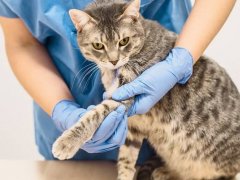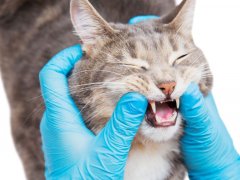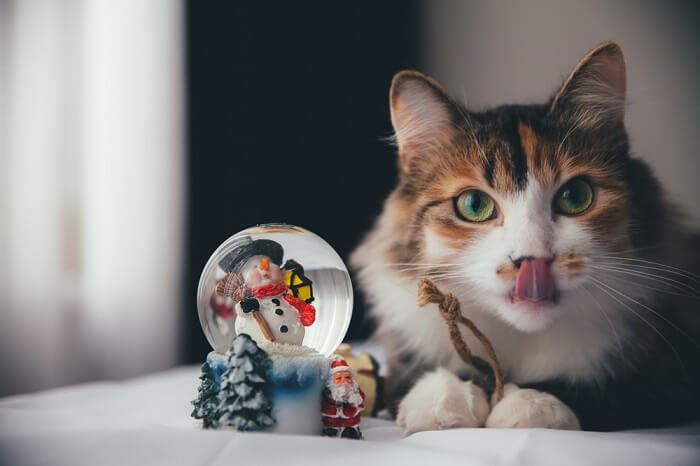
Antifreeze is one of the most common poisonings to affect cats, and it’s commonly fatal. This article aims to explain the background to antifreeze poisoning, helping cat owners to understand why it happens, what can be done if their cat is affected, and how to prevent it from happening in the first place.
Quick Overview: Antifreeze Poisoning in Cats





About Antifreeze Poisoning in Cats
Antifreeze is an additive that lowers the freezing temperature of water. It is usually a colored liquid (e.g. fluorescent green, red, orange, yellow, or blue) that’s mixed with water to prevent car engines from freezing up or being damaged during extremely cold temperatures.
The chemicals also have the effect of making engine coolants more effective at higher temperatures, so they are often used for summer conditions as well. A one-to-one dilution with water is often used, reducing the freezing point of the resulting solution to around −34 °F (−37 °C), depending on the formulation.
As well as for automobile use in car radiators, antifreeze products may also be found in hydraulic brake fluid, heat exchangers, solar thermal units, toilet winterising fluids, the bases of home-use basketball nets, and some “snow globes” which may be sold as ornaments.
There are three chemicals that may be used in antifreeze: ethylene glycol is the most common, and the most dangerous, but methanol and propylene glycol may also be used.
This article is primarily about ethylene glycol poisoning.
- Ethylene glycol is the most common and the most toxic form of antifreeze. The minimum lethal dose of undiluted ethylene glycol antifreeze is around 1.4ml/kg in cats, or just over a teaspoonful for a typical cat of 4kg (8.8 lbs) body weight. A cat could easily consume this much by briefly lapping a spilt puddle of antifreeze from a garage floor. The liquid has a sweet taste that cats enjoy, which is one of the reasons why this is such a hazard. Ethylene glycol causes an upset to the metabolism, known as acidosis, along with severe kidney damage known as acute renal tubular necrosis which can develop within hours of consumption. One of the metabolites of ethylene glycol binds to calcium in the bloodstream to form calcium oxalate crystals which settle in the kidneys: these are thought to be the main cause of the kidney failure that develops with this toxicity.
- Propylene glycol is sometimes sold as a safer type of engine antifreeze/ coolant, and while it is less toxic than ethylene glycol, it is still poisonous to cats, causing acidosis, as well as liver and kidney damage.
- Methanol (also known as methyl alcohol or wood alcohol) is most often used in antifreeze preparations for windscreen washer fluid. This is far less toxic than ethylene glycol, but it can also cause acidosis if a large enough amount of antifreeze is consumed. Cats would need to drink around 5ml per kg for a fatal dose, or around 25ml (5 teaspoonfuls) for a typical cat. This is unlikely to happen, as cats do not like the taste of methanol.
Symptoms of Antifreeze Poisoning in Cats
Antifreeze causes three stages of poisonings which are reflected in the clinical signs which start to develop within hours of ingestion of the poison.
- Acute neurological signs and digestive tract irritation. Affected cats are disorientated, ataxia, staggering, dull, with a lack of appetite, salivation, drooling, and often vomiting and diarrhea. These signs may start within half an hour of ingesting the poison and can last for up to twelve hours.
- Metabolic Acidosis: From 12 to 24 hours after ingestion, cats often develop severe metabolic acidosis, with dullness, inappetence and breathing difficulties (cats often pant, in an attempt to create “respiratory alkalosis” to counter the metabolic acidosis caused by the poison). Excessive thirst and urination (polyuria polydipsia, abbreviated to PUPD) may be seen, along with hypothermia (sub-normal body temperature), muscle twitching, tachycardia (rapid heart rate), meiosis (constricted pupils), and seizures or coma.
- Renal Failure. Around 24-72 hours after ingestion, affected cats develop so-called oliguric or anuric renal failure (the kidneys stop functioning, with little or no urine production). At this stage, dullness, more vomiting, more seizures, and oral ulceration may be seen.
These three stages are not always clearly seen as separate phases, and may merge with each other. Affected cats may die at any point in the course of poisoning. The amount of ethylene glycol that has been consumed has a highly significant impact on the outcome of the poisoning.
Also Read: Signs of Poisoning in Cats: Causes, Symptoms, and Treatment
Immediate treatment is absolutely critical in cases of antifreeze poisoning in cats: you need to get your pet to the vet as an absolute emergency, without delay. You may wish to call a pet poison helpline on your way to the emergency veterinarian, to prepare yourself for the questions that you may be asked later.
Diagnosis of Antifreeze Poisoning in Cats
1. Detailed History Taking
Your vet will discuss every aspect of your cat’s background and overall care. The circumstances will often give rise to a suspicion of antifreeze exposure (e.g. an unwell cat having had access to a puddle of antifreeze in the garage).
2. Physical Examination
Your veterinarian will check your cat over carefully, checking for the signs of antifreeze poisoning. When the abdomen is palpated, enlarged, painful kidneys may be felt. An ultraviolet lamp may be used to check for the fluorescent chemicals that are sometimes used to color antifreeze: inspection of the oral cavity, any vomit or feces, and urine may demonstrate fluorescence.
3. Routine Blood Tests
It’s very likely that your veterinarian may carry out other blood work, including the usual panel of diagnostic tests, such as hematology (blood count) and biochemistry profiles.
Early on, non-specific changes such as hemoconcentration may be seen, but later in the disease, biochemical evidence of acute renal failure, such as raised phosphorus, urea, creatinine and potassium may be seen.
4. Specialised Blood Tests
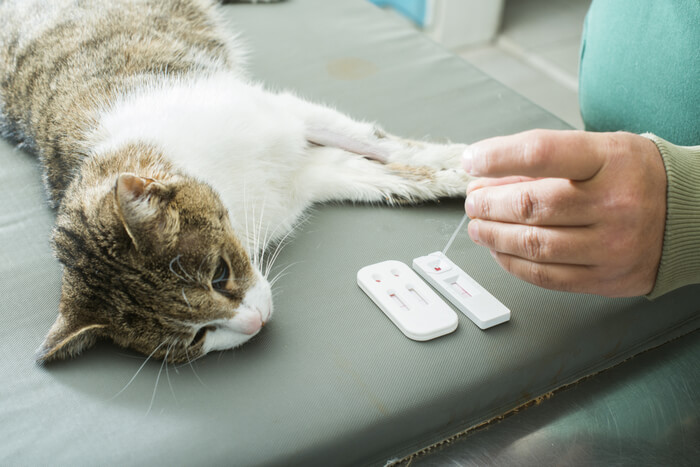
Prior to a blood transfusion, a blood test will allow your veterinarian to
Your veterinarian may recommend specific blood tests to detect ethylene glycol: these may be done through in-clinic kits, or the sample may need to be sent to an external laboratory.
Also Read: Cat Bloodwork (Different Types of Tests, Health Conditions And Costs)
5. Urine Tests
Routine urine tests (urinalysis) may reveal that the urine is more dilute than normal (isosthenuric which means a specific gravity of between 1.008 – 1.015). Urine sediment may contain so-called casts, with blood cells and kidney cells. The classic calcium oxalate crystals that settle in the kidneys may be seen in the urine, but they may not be visible until late in the course of the poisoning.
6. Other Tests
Ultrasound examination of the abdomen may show the characteristic changes in the kidneys caused by ethylene glycol.
Treatment of Antifreeze Poisoning in Cats
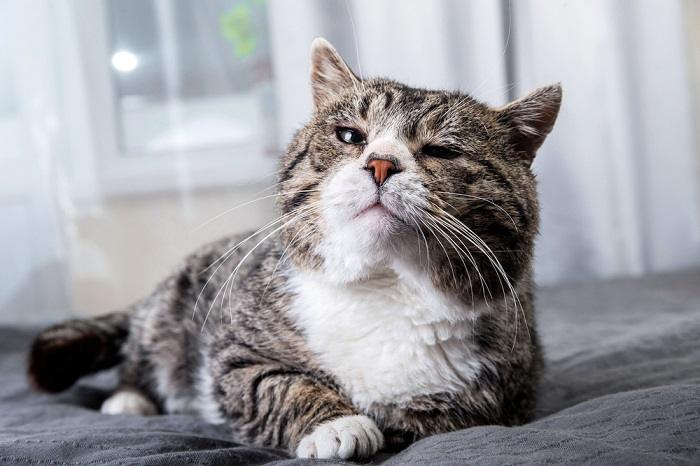
Induction of emesis (vomiting) can be an effective way of removing the antifreeze from the cat’s stomach if this is carried out promptly enough (ideally within half an hour of ingestion). Additional treatment is important even if this is carried out.
Ideally, one of the two antidotes to antifreeze poisoning should be given as soon as possible after the poison has been consumed: if more than three hours have passed, the chances of successful treatment are slim.
Both antidotes work by preventing ethylene glycol from being metabolised into its toxic by-products, which is why prompt treatment is so important.
- Fomepizole acts by inhibiting an enzyme in the bloodstream called alcohol dehydrogenase. Treatment may cause sedation but the side effects are less severe than when ethanol is used. Usually, an intravenous dose is given initially, then this is topped up twice daily, depending on blood test results.
- Ethanol directly competes with ethylene glycol for alcohol dehydrogenase, reducing the poison’s metabolism, but as an alcohol itself, it too causes vomiting, depression, and acidosis. For this reason, careful monitoring is needed, with frequent redosing (eg every four hours) depending on the patient’s condition.
General supportive treatment is also important, including intravenous fluids, B vitamins, anti-emetics, and good nursing care. Intensive monitoring, including repeated blood tests, is an important part of the care of these patients. In severe cases, dialysis and even renal transplants may be discussed, if they are available.
Prevention of Antifreeze Poisoning in Cat
Pet owners should store antifreeze safely, out of the reach of pets, and any accidental spills should be cleaned up immediately. Cats should not be allowed into working areas at times when antifreeze is being topped up.
Conclusion
Antifreeze poisoning is a common problem in cats, more commonly seen in the winter months. Ideally, the problem should be prevented by careful use of antifreeze chemicals, but if a cat is known to ingest this substance, prompt action by taking the cat to the emergency veterinarian is essential and can be life-saving.
Frequently Asked Questions
Why do cats like antifreeze?
Ethylene glycol is said to have a sweet taste that cats find palatable, although recent studies suggest that the real attraction is simply that if cats are thirsty, they drink the substance as an alternative to water.
How long will a cat live after ingesting antifreeze?
If untreated, a cat may live for 12 to 72 hours after poisoning, depending on how much was consumed.
How long can a cat survive after being poisoned?
If a cat is successfully treated, they may recover enough to have a normal lifespan.
How do you treat a poisoned cat?
Treatment details are listed above, but as with most poisonings, initial induction of vomiting is helpful, followed by the specific use of antidotes that stop the antifreeze from having its most toxic effects, combined with general supportive care of the patient.

